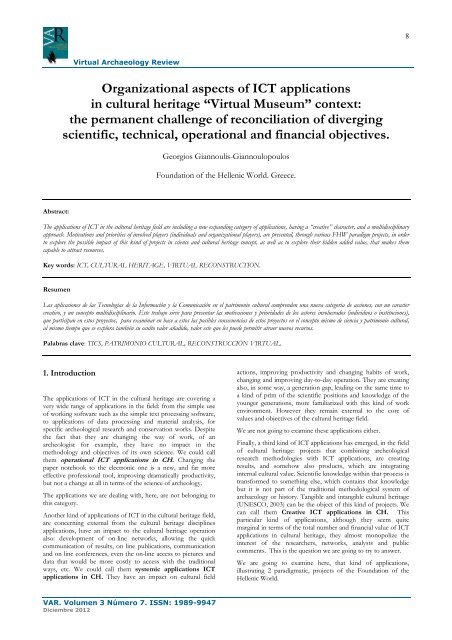Virtual Museums
Virtual Museums
Virtual Museums
Create successful ePaper yourself
Turn your PDF publications into a flip-book with our unique Google optimized e-Paper software.
Abstract:<br />
<strong>Virtual</strong> Archaeology Review<br />
Organizational aspects of ICT applications<br />
in cultural heritage “<strong>Virtual</strong> Museum” context:<br />
the permanent challenge of reconciliation of diverging<br />
scientific, technical, operational and financial objectives.<br />
VAR. Volumen 3 Número 7. ISSN: 1989-9947<br />
Diciembre 2012<br />
Georgios Giannoulis-Giannoulopoulos<br />
Foundation of the Hellenic World. Greece.<br />
The applications of ICT in the cultural heritage field are including a new expanding category of applications, having a “creative” character, and a multidisciplinary<br />
approach. Motivations and priorities of involved players (individuals and organizational players), are presented, through various FHW paradigm projects, in order<br />
to explore the possible impact of this kind of projects in science and cultural heritage concept, as well as to explore their hidden added value, that makes them<br />
capable to attract resources.<br />
Key words: ICT, CULTURAL HERITAGE, VIRTUAL RECONSTRUCTION.<br />
Resumen<br />
Las aplicaciones de las Tecnologías de la Información y la Comunicación en el patrimonio cultural comprenden una nueva categoria de acciones, con un caracter<br />
creativo, y un concepto multidisciplinario. Este trabajo sirve para presentar las motivaciones y prioridades de los actores involucrados (individuos o instituciones),<br />
que participan en estos proyectos, para examinar en base a estos las posibles consecuencias de estos proyectos en el concepto mismo de ciencia y patrimonio cultural,<br />
al mismo tiempo que se explora también su oculto valor añadido, valor este que les puede permitir atraer nuevos recursos.<br />
Palabras clave: TICS, PATRIMONIO CULTURAL, RECONSTRUCCIÓN VIRTUAL.<br />
1. Introduction<br />
The applications of ICT in the cultural heritage are covering a<br />
very wide range of applications in the field: from the simple use<br />
of working software such as the simple text processing software,<br />
to applications of data processing and material analysis, for<br />
specific archeological research and conservation works. Despite<br />
the fact that they are changing the way of work, of an<br />
archeologist for example, they have no impact in the<br />
methodology and objectives of its own science. We could call<br />
them operational ICT applications in CH. Changing the<br />
paper notebook to the electronic one is a new, and far more<br />
effective professional tool, improving dramatically productivity,<br />
but not a change at all in terms of the science of archeology.<br />
The applications we are dealing with, here, are not belonging to<br />
this category.<br />
Another kind of applications of ICT in the cultural heritage field,<br />
are concerning external from the cultural heritage disciplines<br />
applications, have an impact to the cultural heritage operation<br />
also: development of on-line networks, allowing the quick<br />
communication of results, on line publications, communication<br />
and on line conferences, even the on-line access to pictures and<br />
data that would be more costly to access with the traditional<br />
ways, etc. We could call them systemic applications ICT<br />
applications in CH. They have an impact on cultural field<br />
actions, improving productivity and changing habits of work,<br />
changing and improving day-to-day operation. They are creating<br />
also, in some way, a generation gap, leading on the same time to<br />
a kind of prim of the scientific positions and knowledge of the<br />
younger generations, more familiarized with this kind of work<br />
environment. However they remain external to the core of<br />
values and objectives of the cultural heritage field.<br />
We are not going to examine these applications either.<br />
Finally, a third kind of ICT applications has emerged, in the field<br />
of cultural heritage: projects that combining archeological<br />
research methodologies with ICT applications, are creating<br />
results, and somehow also products, which are integrating<br />
internal cultural value. Scientific knowledge within that process is<br />
transformed to something else, which contains that knowledge<br />
but it is not part of the traditional methodological system of<br />
archaeology or history. Tangible and intangible cultural heritage<br />
(UNESCO, 2003) can be the object of this kind of projects. We<br />
can call them Creative ICT applications in CH. This<br />
particular kind of applications, although they seem quite<br />
marginal in terms of the total number and financial value of ICT<br />
applications in cultural heritage, they almost monopolize the<br />
interest of the researchers, networks, analysts and public<br />
comments. This is the question we are going to try to answer.<br />
We are going to examine here, that kind of applications,<br />
illustrating 2 paradigmatic, projects of the Foundation of the<br />
Hellenic World.<br />
8


